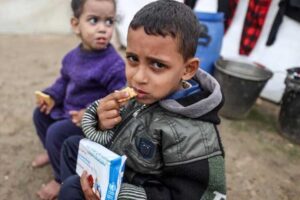
Asia-Pacific, Civil Society, Climate Action, Climate Change, Conferences, Development & Aid, Environment, Featured, Gender, Headlines, Population, Sustainable Development Goals, TerraViva United Nations, Women & Climate Change

Secretary General of AFPPD, Dr. Jetn Sirathranont, addresses a conference with the theme Gender Empowerment for a Green Economy in Islamabad, Pakistan. Credit: AFPPD
– Robust data collection, integrated policies, and an accelerated push towards a green economy with a gender focus topped the agenda at a conference in Islamabad, Pakistan, that brought together policymakers, experts, and advocates from across the Asia-Pacific region.
The conference, with the theme Gender Empowerment for a Green Economy, focused on critical issues at the intersection of gender equality, climate change, and sustainable development. Held on August 12 and 13, 2024, it was convened by the Asian Forum of Parliamentarians on Population and Development (AFPPD).
Participants called for immediate action to empower women and ensure their active participation in sustainable development efforts across the region, especially since the conference coincided with the 30th anniversary of the Cairo Programme of Action from the International Conference on Population and Development (ICPD).
Romina Khurshid Alam, Coordinator to the Prime Minister on Climate Change at the Ministry of Climate Change and Environmental Coordination, set the tone for the event by highlighting Pakistan’s ongoing efforts to integrate gender perspectives into national climate policies.
“As parliamentarians, we hold the power to shape policies and laws that can drive gender equality and environmental sustainability. We must advocate for and enact legislation that ensures women have equal access to opportunities in the green economy, whether it be in renewable energy, sustainable agriculture, or ecosystem management,” Alam said.
The Secretary General of AFPPD, Dr. Jetn Sirathranont, emphasized that gender equality is not merely a fundamental human right but a crucial element for creating a positive and sustainable society. He noted that traditional stereotypes continue to perpetuate inequalities and stressed the importance of placing women at the center of efforts to develop a more inclusive and sustainable economy.
Toshiko Abe, MP and State Minister of Education, Culture, Sports, Science, and Technology of Japan, emphasized the AFPPD’s role. She said the organization plays a crucial role in addressing gender issues, particularly in countries where women’s equality is lagging. She commended the collective efforts of Asian countries towards a gendered green economy.
However, Latika Maskey Pradhan, Deputy Representative of UNFPA Pakistan, warned that the full potential of women remains untapped, constrained by social norms, discriminatory practices, and limited access to resources and decision-making spaces.
In an interview with IPS, Pradhan further highlighted three key areas that the UN is focusing on at the grassroots level to change societal mindsets:
- Investing in women’s education and skills development: Recognizing the importance of equipping women with the necessary education and skills to thrive in various sectors.
- Reproductive health and rights: Emphasizing that access to reproductive health and rights is integral to achieving gender equality and empowering women.
- Supporting women’s entrepreneurship and leadership: Advocating for the economic empowerment of women by providing opportunities for entrepreneurship and leadership roles.
Tabinda Sarosh, interim Chief Executive Officer of Pathfinder International, highlighted the impacts of climate change-related disasters. In 2022, severe flooding in Pakistan resulted in the displacement of 625,000 pregnant women. In a single month, around 70,000 of them gave birth in camps, where delivery conditions are often unsafe.

Delegates at the AFPPD conference on Gender Empowerment for a Green Economy in Islamabad. Credit: AFPPD
Gender and Equality Intertwined
The keynote address, delivered by Pakistan’s National Assembly Speaker, Sardar Ayaz Sadiq, underscored the importance of the event at the highest levels of government.
“The theme, ‘Gender Empowerment for a Green Economy,’ is both timely and essential for our collective future. As parliamentarians, we must recognize that gender equality and environmental sustainability are deeply intertwined goals; the success of one depends on the other,” Sadiq said.
Fauzia Waqar, Federal Ombudsman Secretariat for Protection Against Harassment (FOSPAH), agreed, saying “Improvement in policies needs to be gender-affirmative, focusing on recruitment, retention, and the provision of basic facilities for women.”
Accountability was crucial. “There needs to be a national survey for the well-being of women, but currently, the baseline data is not available,” said Saliha Ramay from UNFPA. These insights underscore the need for continued efforts to promote gender equality.
One of the conference’s highlights was the session on women’s role in global crises, particularly focusing on climate change and security. Parliamentarians from Cambodia and the Maldives, along with representatives from international organizations, shared their perspectives on how women are uniquely positioned to lead in climate action and peacebuilding efforts.
Poverty, Gender and Climate Action
Ly Kimlieng, MP from Cambodia, highlighted the intersection of poverty and gender issues, stating, “Gender-responsive climate action is needed as Cambodia works with agriculture and technology to create solutions and remove gender biases.”
Ensuring community involvement was crucial. Lydia Saloucou, President of Pathfinder International’s Africa Region, told the conference: “We need to protect our next generation by collaborating with the community and affected populations to find solutions.”
Women’s role in climate change mitigation, adaptation and agriculture shouldn’t be underestimated said Dr. Anara Naeem, MP from the Maldives.
“Women’s role is invaluable in climate adaptation, with their crucial involvement in food production and capacity building.”
Guncha Annageldieva, YPEER International Coordinator from Turkmenistan, called for integrating sexual and reproductive health into climate discourse, stating, “Investing in sexual and reproductive health within climate action empowers women and prevents future disaster management costs.”
Women Key to Sustainable Development
Presentations from Indonesian parliamentarians, youth representatives, and economic experts highlighted the importance of investing in women’s economic empowerment as a key driver of sustainable development.
Jasmin Sri Wulan Sutomo, an MP from Indonesia, pointed out the ongoing challenges despite the country’s significant economic progress. She noted, “Women’s labor participation remains stagnant due to factors like the wage gap, unplanned pregnancies, and old informal labor practices.”
Jayaa Jaggi, Advocacy Manager at YPEER Pakistan, highlighted the disparity in Pakistan, noting that the gap for women is vast and young minority women have limited exposure to education and economic opportunities.
A presentation by Durre Nayab from UNFPA & PIDE addressed the demographic dividend and gender perspective through National Transfer Accounts, revealing that “women are more involved in unpaid labor while men predominantly work in the paid economy,” stressing the need to recognize women’s contributions beyond market-based work.
A crucial session emphasized the need for gender-responsive policies to empower women to address climate change. Policymakers and experts discussed specific risks faced by women and girls, advocating for enhanced investment in women’s capabilities and private sector engagement to support a transition to green and blue economies.
Women’s Role in Strong Climate Policies Lauded
Dr. AbdelHady El Kasbey, an MP from Egypt, highlighted the importance of women’s leadership in environmental policies, stating, “Countries with more women in parliament often see stronger national climate change policies adopted, leading to lower emissions and more equitable governance of natural resources.”
He stressed the need for gender-responsive financing, noting that despite billions of dollars invested in environmental issues, “less than 1% of this market aligns with women’s empowerment goals.”
Mr. Abid Qaiyum Suleri, Executive Director of SDPI, called for gender-segregated data to support gender-responsive policies, emphasizing, “Decision-makers can utilize the power of women as agents of change to adopt pro-environmental practices and turn challenges around for us.” He highlighted the need for a credible baseline to empower women to address the effects of climate change.
Climate-Resilient Healthcare Systems
The spotlight then turned to healthcare systems that are both climate-resilient and equitable. Experts presented strategies for ensuring that health systems can withstand the impacts of climate change while providing accessible care to all, particularly women and marginalized communities.
Zeeshan Salahuddin, MP from Tabadlab, highlighted the overlooked impacts of climate-induced events, stressing the importance of integrating climate considerations into national policies. He remarked, “To address these issues, there is a need to strengthen provincial departments, improve climate health financing, and explore climate debt swaps to alleviate financial and climate burdens.”
Islamabad Declaration
The conference concluded with the adoption of the Islamabad Declaration, reaffirming the commitment of participating nations and organizations to advancing gender equality, women’s empowerment, and climate action. The declaration outlined key commitments, including reaffirming support for the ICPD Programme of Action and the 2030 Agenda for Sustainable Development, acknowledging the severe impacts of climate change on vulnerable countries, and emphasizing the importance of building resilience through investments in emergency preparedness and disaster risk reduction.
As the conference ended, participants left with a renewed sense of urgency and commitment to addressing the interconnected challenges of gender inequality and climate change. The event served as a powerful reminder that empowering women is not just a matter of social justice, but a critical strategy for building a more sustainable and resilient future for all.
Note: The Asian Population and Development Association (APDA) and the Asian Forum of Parliamentarians on Population and Development (AFPPD) in Pakistan organized the meeting. It was supported by the United Nations Population Fund (UNFPA) and Japan Trust Fund (JTF).
IPS UN Bureau Report







